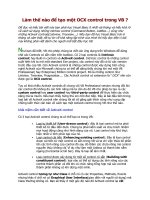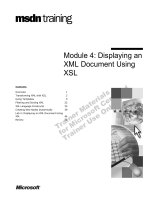Tài liệu Administration Guide Version NGX R65 doc
Bạn đang xem bản rút gọn của tài liệu. Xem và tải ngay bản đầy đủ của tài liệu tại đây (1.69 MB, 186 trang )
UserAuthority
Administration Guide
Version NGX R65
700358 March 7, 2007
TM
© 2003-2007 Check Point Software Technologies Ltd.
All rights reserved. This product and related documentation are protected by copyright and distributed under licensing restricting their use, copying,
distribution, and decompilation. No part of this product or related documentation may be reproduced in any form or by any means without prior written
authorization of Check Point. While every precaution has been taken in the preparation of this book, Check Point assumes no responsibility for errors or
omissions. This publication and features described herein are subject to change without notice.
RESTRICTED RIGHTS LEGEND:
Use, duplication, or disclosure by the government is subject to restrictions as set forth in subparagraph (c)(1)(ii) of the Rights in Technical Data and Computer
Software clause at DFARS 252.227-7013 and FAR 52.227-19.
TRADEMARKS:
©2003-2007 Check Point Software Technologies Ltd. All rights reserved. Check Point, AlertAdvisor, Application Intelligence, Check Point Express, Check Point
Express CI, the Check Point logo, ClusterXL, Confidence Indexing, ConnectControl, Connectra, Connectra Accelerator Card, Cooperative Enforcement,
Cooperative Security Alliance, CoSa, DefenseNet, Dynamic Shielding Architecture, Eventia, Eventia Analyzer, Eventia Reporter, Eventia Suite, FireWall-1,
FireWall-1 GX, FireWall-1 SecureServer, FloodGate-1, Hacker ID, Hybrid Detection Engine, IMsecure, INSPECT, INSPECT XL, Integrity, Integrity Clientless
Security, Integrity SecureClient, InterSpect, IPS-1, IQ Engine, MailSafe, NG, NGX, Open Security Extension, OPSEC, OSFirewall, Policy Lifecycle Management,
Provider-1, Safe@Home, Safe@Office, SecureClient, SecureClient Mobile, SecureKnowledge, SecurePlatform, SecurePlatform Pro, SecuRemote, SecureServer,
SecureUpdate, SecureXL, SecureXL Turbocard, Sentivist, SiteManager-1, SmartCenter, SmartCenter Express, SmartCenter Power, SmartCenter Pro,
SmartCenter UTM, SmartConsole, SmartDashboard, SmartDefense, SmartDefense Advisor, Smarter Security, SmartLSM, SmartMap, SmartPortal,
SmartUpdate, SmartView, SmartView Monitor, SmartView Reporter, SmartView Status, SmartViewTracker, SofaWare, SSL Network Extender, Stateful Clustering,
TrueVector, Turbocard, UAM, UserAuthority, User-to-Address Mapping, VPN-1, VPN-1 Accelerator Card, VPN-1 Edge, VPN-1 Express, VPN-1 Express CI, VPN-
1 Power, VPN-1 Power VSX, VPN-1 Pro, VPN-1 SecureClient, VPN-1 SecuRemote, VPN-1 SecureServer, VPN-1 UTM, VPN-1 UTM Edge, VPN-1 VSX, Web
Intelligence, ZoneAlarm, ZoneAlarm Anti-Spyware, ZoneAlarm Antivirus, ZoneAlarm Internet Security Suite, ZoneAlarm Pro, ZoneAlarm Secure Wireless Router,
Zone Labs, and the Zone Labs logo are trademarks or registered trademarks of Check Point Software Technologies Ltd. or its affiliates. ZoneAlarm is a Check
Point Software Technologies, Inc. Company. All other product names mentioned herein are trademarks or registered trademarks of their respective owners. The
products described in this document are protected by U.S. Patent No. 5,606,668, 5,835,726, 6,496,935, 6,873,988, and 6,850,943 and may be protected by
other U.S. Patents, foreign patents, or pending applications.
For third party notices, see: THIRD PARTY TRADEMARKS AND COPYRIGHTS.
Table of Contents 5
Contents
Preface Who Should Use This Administration Guide 10
Summary of Contents 11
Appendices 12
Related Documentation 13
More Information 16
Feedback 17
Chapter 1 Introduction
The Need for UserAuthority 20
Identity-based Access Control for Outbound Connections via VPN-1 Power Gateway
21
Underlying Concept and Advantage 22
Typical Deployment 23
UserAuthority SSO for VPN-1 Power Deployment 23
OPSEC Protocols 25
How to Use this Administration Guide 26
Chapter 2 UserAuthority Deployments and Installation
Overview 28
Deployments 29
Outbound Access Control 29
Citrix MetaFrame or Windows Terminal Services 34
Supported Platforms 37
Installation and Configuration 38
Installing and Configuring UAS on VPN-1 Power 38
Installing and Configuring the UAS on the Windows DC 49
Chapter 3 Outbound Access Control
The Challenge 60
The UserAuthority Solution 61
Identification using SecureAgent 63
Identity Sharing 63
Retrieving Windows Groups with UserAuthority 68
Outbound Access Control using Citrix Terminals as TIP 69
Scenario - An Organization using Multiple Windows DCs 70
Scenario - An Organization Using Multiple Domains 72
Configurations 74
Adding Additional Windows DCs 74
Outbound Access Control on Citrix or Windows Terminals 75
Configuring UserAuthority Domain Equality 75
6
Chapter 4 User Management in UserAuthority
Overview 80
Managing Users and Groups 81
Users in UserAuthority 81
User Groups in UserAuthority 81
Using a Local Check Point Database 83
Using an External Database 84
Using the Windows User Identity 85
Users in the Windows Domain 85
Configuring UserAuthority to Recognize Windows User Groups 85
Chapter 5 Auditing in UserAuthority
Overview 88
Using Logs for Auditing 89
Auditing Outbound Traffic Using UserAuthority Outbound Access Control 90
Configuring UserAuthority for Auditing 94
Configuring Auditing of Requests for External Resources 94
Chapter 6 High Availability and Load Balancing
Overview 96
High Availability 96
Load Balancing 96
High Availability and Load Balancing in UserAuthority 97
Using Multiple Windows DCs 98
Using a VPN-1 Power Cluster 99
Chapter 7 UserAuthority CLIs
Chapter 8 UserAuthority OPSEC APIs
Overview 110
Programming Model 111
Defining a UAA Client 114
Client Server Configuration 114
OPSEC UserAuthority API Overview 114
Function Calls 125
Session Management 125
Assertions Management 126
Managing Queries 129
Managing Updates 130
Managing Authentication Requests 131
Assertions Iteration 132
Managing UAA Errors 134
Debugging 135
Event Handlers 136
UAA_QUERY_REPLY Event Handler 136
UAA_UPDATE_REPLY Event Handler 137
Table of Contents 7
UAA_AUTHENTICATE_REPLY Event Handler 138
Chapter 9 Monitoring the UserAuthority Environment
Overview 142
System Monitoring 143
Monitoring the System Status 143
User Monitoring 148
Monitoring User Activities 148
Monitoring Example: SecureAgent Cannot Provide User Identity 149
Chapter 10 Troubleshooting UserAuthority
Overview 152
General Problems 153
Why is there no established SIC? 153
Why are Domain Controller Queries not Sent Properly? 156
User-Related Problems 157
Why does SecureAgent not identify the user? 157
Why are Terminal Server Clients not Identified by UAS? 160
Why does the Firewall Report Identify Users as Unknown? 161
Appendix A Integrating UserAuthority with Meta IP
Overview 164
Required Components 165
Preliminary Steps 166
Windows DC Configuration 167
VPN-1 Power Policy Configuration 168
DHCP Server Configuration 170
Appendix B Glossary
Acronyms and Abbreviations 176
Index 183
8
9
Preface
P
Preface
In This Chapter
Who Should Use This Administration Guide page 10
Summary of Contents page 11
Related Documentation page 13
More Information page 16
Feedback page 17
Who Should Use This Administration Guide
10
Who Should Use This Administration Guide
This Administration Guide is intended for administrators responsible for
maintaining network security within an enterprise, including policy management
and user support.
This Administration Guide assumes a basic understanding of
• System administration.
• The underlying operating system.
• Internet protocols (IP, TCP, UDP etc.).
Summary of Contents
Chapter Preface 11
Summary of Contents
This Administration Guide provides step-by-step instructions for configuring
UserAuthority.
In order to assist you in the deployment of UserAuthority, this Administration Guide
contains various scenarios that suit the deployments of most enterprises. These
scenarios are followed by detailed workflow that can be used to help with your
deployment. You can also combine the deployments and workflow described in this
Administration Guide to best suit the deployment in your enterprise.
Table A-1
Chapter Description
Chapter 1, “Introduction” describes the User Authority concept,
deployment and management solution.
Chapter 2, “UserAuthority
Deployments and
Installation”
provides the foundation for the deployment of
UserAuthority in its most basic form
Chapter 3, “Outbound Access
Control”
describes UserAuthority’s part in access to
external resources.
Chapter 4, “User
Management in
UserAuthority”
provides information about managing users and
groups with a Check Point database and external
databases.
Chapter 5, “Auditing in
UserAuthority”
explains how UserAuthority uses the SmartView
Tracker, Check Point's advanced tracking tool, to
enable auditing of both UserAuthority Server
(UAS).
Chapter 6, “High Availability
and Load Balancing”
describes how the UserAuthority Server (UAS)
can be configured to provide both high
availability and load balancing.
Chapter 7, “UserAuthority
CLIs”
explains the UserAuthority command line
interfaces.
Appendices
12
Appendices
This Administration Guide contains the following appendices:
Chapter 8, “UserAuthority
OPSEC APIs”
describes OPSEC APIs
Chapter 9, “Monitoring the
UserAuthority Environment”
describes how system and user monitoring allows
the system administrator to view the system
status for debugging and problem solving in the
system.
Chapter 10, “Troubleshooting
UserAuthority”
provides help for common problems that might
arise when using UserAuthority.
Table A-1
Chapter Description
Table A-2
Appendix Description
Appendix A, “Integrating
UserAuthority with Meta IP”
explains how UserAuthority can easily be
integrated with the Meat IP product to provide
authenticated IP addresses from an
authenticated IP pool to authenticated users.
Appendix B, “Glossary” describes the acronyms and abbreviations used
in this Administration Guide.
Related Documentation
Chapter Preface 13
Related Documentation
The NGX R65 release includes the following documentation
TABLE P-1 VPN-1 Power documentation suite documentation
Title Description
Internet Security Product
Suite Getting Started
Guide
Contains an overview of NGX R65 and step by step
product installation and upgrade procedures. This
document also provides information about What’s
New, Licenses, Minimum hardware and software
requirements, etc.
Upgrade Guide Explains all available upgrade paths for Check Point
products from VPN-1/FireWall-1 NG forward. This
guide is specifically geared towards upgrading to
NGX R65.
SmartCenter
Administration Guide
Explains SmartCenter Management solutions. This
guide provides solutions for control over
configuring, managing, and monitoring security
deployments at the perimeter, inside the network, at
all user endpoints.
Firewall and
SmartDefense
Administration Guide
Describes how to control and secure network
access; establish network connectivity; use
SmartDefense to protect against network and
application level attacks; use Web Intelligence to
protect web servers and applications; the integrated
web security capabilities; use Content Vectoring
Protocol (CVP) applications for anti-virus protection,
and URL Filtering (UFP) applications for limiting
access to web sites; secure VoIP traffic.
Virtual Private Networks
Administration Guide
This guide describes the basic components of a
VPN and provides the background for the
technology that comprises the VPN infrastructure.
Related Documentation
14
Eventia Reporter
Administration Guide
Explains how to monitor and audit traffic, and
generate detailed or summarized reports in the
format of your choice (list, vertical bar, pie chart
etc.) for all events logged by Check Point VPN-1
Power, SecureClient and SmartDefense.
SecurePlatform™/
SecurePlatform Pro
Administration Guide
Explains how to install and configure
SecurePlatform. This guide will also teach you how
to manage your SecurePlatform machine and
explains Dynamic Routing (Unicast and Multicast)
protocols.
Provider-1/SiteManager-1
Administration Guide
Explains the Provider-1/SiteManager-1 security
management solution. This guide provides details
about a three-tier, multi-policy management
architecture and a host of Network Operating Center
oriented features that automate time-consuming
repetitive tasks common in Network Operating
Center environments.
TABLE P-2 Integrity Server documentation
Title Description
Integrity Advanced
Server Installation
Guide
Explains how to install, configure, and maintain the
Integrity Advanced Server.
Integrity Advanced
Server Administrator
Console Reference
Provides screen-by-screen descriptions of user
interface elements, with cross-references to relevant
chapters of the Administrator Guide. This document
contains an overview of Administrator Console
navigation, including use of the help system.
Integrity Advanced
Server Administrator
Guide
Explains how to managing administrators and
endpoint security with Integrity Advanced Server.
Integrity Advanced
Server Gateway
Integration Guide
Provides information about how to integrating your
Virtual Private Network gateway device with Integrity
Advanced Server. This guide also contains information
regarding deploying the unified SecureClient/Integrity
client package.
TABLE P-1 VPN-1 Power documentation suite documentation (continued)
Title Description
Related Documentation
Chapter Preface 15
Integrity Advanced
Server System
Requirements
Provides information about client and server
requirements.
Integrity Agent for Linux
Installation and
Configuration Guide
Explains how to install and configure Integrity Agent
for Linux.
Integrity XML Policy
Reference Guide
Provides the contents of Integrity client XML policy
files.
Integrity Client
Management Guide
Explains how to use of command line parameters to
control Integrity client installer behavior and
post-installation behavior.
TABLE P-2 Integrity Server documentation (continued)
Title Description
More Information
16
More Information
• For additional technical information about Check Point products, consult Check
Point’s SecureKnowledge at />• See the latest version of this document in the User Center at
/>Feedback
Chapter Preface 17
Feedback
Check Point is engaged in a continuous effort to improve its documentation. Please
help us by sending your comments to:
Feedback
18
19
Chapter
1
Introduction
In This Chapter
The Need for UserAuthority page 20
Underlying Concept and Advantage page 22
Typical Deployment page 23
OPSEC Protocols page 25
How to Use this Administration Guide page 26
The Need for UserAuthority
20
The Need for UserAuthority
In today’s business environment, enterprises need to provide employees, partners
and customers with the ability to access and work with many different applications
and services. It is important that access to these applications be simple and
convenient, and, at the same time, secure, reliable, and easy to manage.
UserAuthority is able to leverage the security needs of your existing or new
environment to higher levels.
UserAuthority can improve access control management in your enterprise with
identity-based access control for outbound connections via the VPN-1 Power
gateway.
Identity-based Access Control for Outbound Connections via VPN-1 Power Gateway
Chapter 1 Introduction 21
Identity-based Access Control for Outbound
Connections via VPN-1 Power Gateway
UserAuthority can provide access control to external resources at the network level
(Internet or other services outside the perimeter gateway). Through VPN-1 Power
gateways, firewall authentication can be configured in the security policy to supply
such demand (Client, Session authentications). The major difference with
UserAuthority is the benefit of SSO to those authentications, eliminating the need
for the user to re-authenticate. UserAuthority enables the user to be identified
transparently via the gateway without human intervention. This functionality is also
known as UserAuthority SSO for VPN-1 Power or Outbound SSO.
Underlying Concept and Advantage
22
Underlying Concept and Advantage
One of the greatest advantages of UserAuthority is its ability to extract the user
identity from a Trusted Identification Point (TIP). UserAuthority establishes a trust
relationship with TIPs on the network to ensure that it is receiving trusted
information.
UserAuthority TIPs include:
• Windows’ logons to Domain Controllers
• VPN-1 Power authentication (SecureRemote/SecureClient) or any other
authentications to the gateways)
• MS Terminal Services/Citrix MetaFrame servers
Extracting the user identity from the TIP enables the following benefits:
• Once a user is logged on to the system and identified by UserAuthority, there is
no need to authenticate again, even when accessing a Web application.
• Pure SSO, requiring only the initial network log on to a TIP. No other
authentication is required.
• Utilization of existing authentication in the network environment to retrieve user
identification, without requiring the end user to identify to an additional
identification mechanism.
• Integration of network level authentication with Web applications.
• Deployment does not require any changes to Web applications.
Typical Deployment
Chapter 1 Introduction 23
Typical Deployment
This section describes three common types of deployments, and the particular
benefits of integrating UserAuthority into each of the deployment types. A detailed
description of the various UserAuthority deployment types, and how they are set up
and implemented, is presented in Chapter 2, “UserAuthority Deployments and
Installation””.
The following example illustrates identity-based access control for outbound
connections via a VPN-1 Power gateway.
UserAuthority SSO for VPN-1 Power Deployment
UserAuthority can provide authorization to external resources at the network level.
Most enterprises already use VPN-1 Power authentication rules that require client
or session authentication to external resources. UserAuthority expands on this by
providing SSO to VPN-1 Power as well as auditing capabilities.
Figure 1-1 SSO for VPN-1 Power Deployment
UserAuthority eliminates the need for a user to authenticate each time an external
resource is accessed. This is done by using the information on the Windows DC to
identify the user. When the user requests an external resource, the UserAuthority
Server on the VPN-1 Power gateway queries the UserAuthority Server installed in a
Windows DC. The UserAuthority Server on the Windows DC sends a query to a
desktop application called SmartAgent, which identifies the user according to the
Windows DC identification that was used at sign-on.
UserAuthority SSO for VPN-1 Power Deployment
24
This information is sent back to the UserAuthority Server on the VPN-1 Power
gateway to provide authentication on behalf of the user. In this way, the user is
automatically authenticated each time without the need to re-authenticate each
time a request for external resources is made. This scenario is illustrated in
Figure 1-1.
UserAuthority can be also configured to create logs each time a user requests an
external resource. This provides information on how users are accessing external
resources. Logs can provide various types of information, such as whether users are
violating enterprise policy or whether there are communications problems when
trying to access external resources.
UserAuthority extends the capabilities of VPN-1 Power authentication by providing
SSO, which eliminates the need for users to authenticate to VPN-1 Power and
provides auditing capabilities for requests to external resources. For more
information, see Chapter 3, “Outbound Access Control””.
OPSEC Protocols
Chapter 1 Introduction 25
OPSEC Protocols
UserAuthority supports all Check Point Open Platform for Security (OPSEC)
standards. OPSEC provides a single integration framework by using the OPSEC
Software Development Kit (SDK) for integration with Check Point VPN-1 Power.
OPSEC APIs provide solutions for third-party and in-house integration.
The UAA (UserAuthority) API set can be used to create a single authorization
solution for any application. For example, an enterprise might want to use a single
user identification for applications that are not Web-based (such as a client
installation) in addition to their Web applications. The UAA OPSEC API enables the
integration of any application that requires authentication and authorization, and
provides all UserAuthority benefits to the application.
Integration can be easily programmed by in-house programmers using the OPSEC
APIs. In addition, it is possible to turn to an OPSEC partner to develop a solution
for the enterprise. OPSEC partners are a group of professional programmers who
use the OPSEC standard.
For information on the OPSEC UAA API set, see Chapter 8, “UserAuthority OPSEC
APIs””.









